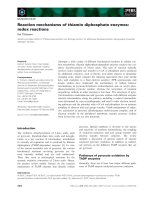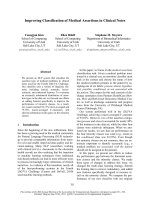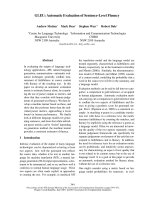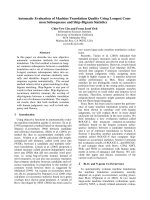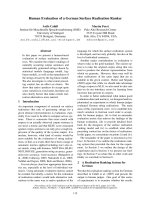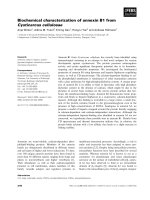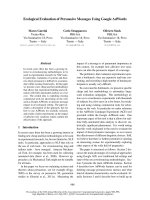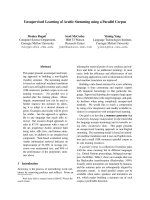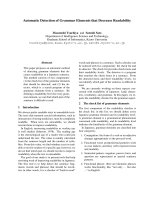Báo cáo khoa học: "Ecological Evaluation of Persuasive Messages Using Google AdWords" pdf
Bạn đang xem bản rút gọn của tài liệu. Xem và tải ngay bản đầy đủ của tài liệu tại đây (153.2 KB, 9 trang )
Proceedings of the 50th Annual Meeting of the Association for Computational Linguistics, pages 988–996,
Jeju, Republic of Korea, 8-14 July 2012.
c
2012 Association for Computational Linguistics
Ecological Evaluation of Persuasive Messages Using Google AdWords
Marco Guerini
Trento-Rise
Via Sommarive 18, Povo
Trento — Italy
Carlo Strapparava
FBK-Irst
Via Sommarive 18, Povo
Trento — Italy
Oliviero Stock
FBK-Irst
Via Sommarive 18, Povo
Trento — Italy
Abstract
In recent years there has been a growing in-
terest in crowdsourcing methodologies to be
used in experimental research for NLP tasks.
In particular, evaluation of systems and theo-
ries about persuasion is difficult to accommo-
date within existing frameworks. In this paper
we present a new cheap and fast methodology
that allows fast experiment building and eval-
uation with fully-automated analysis at a low
cost. The central idea is exploiting existing
commercial tools for advertising on the web,
such as Google AdWords, to measure message
impact in an ecological setting. The paper in-
cludes a description of the approach, tips for
how to use AdWords for scientific research,
and results of pilot experiments on the impact
of affective text variations which confirm the
effectiveness of the approach.
1 Introduction
In recent years there has been a growing interest in
finding new cheap and fast methodologies to be used
in experimental research, for, but not limited to, NLP
tasks. In particular, approaches to NLP that rely on
the use of web tools - for crowdsourcing long and
tedious tasks - have emerged. Amazon Mechani-
cal Turk, for example, has been used for collecting
annotated data (Snow et al., 2008). However ap-
proaches a la Mechanical Turk might not be suitable
for all tasks.
In this paper we focus on evaluating systems and
theories about persuasion, see for example (Fogg,
2009) or the survey on persuasive NL generation
studies in (Guerini et al., 2011a). Measuring the
impact of a message is of paramount importance in
this context, for example how affective text varia-
tions can alter the persuasive impact of a message.
The problem is that evaluation experiments repre-
sent a bottleneck: they are expensive and time con-
suming, and recruiting a high number of human par-
ticipants is usually very difficult.
To overcome this bottleneck, we present a specific
cheap and fast methodology to automatize large-
scale evaluation campaigns. This methodology al-
lows us to crowdsource experiments with thousands
of subjects for a few euros in a few hours, by tweak-
ing and using existing commercial tools for adver-
tising on the web. In particular we make reference
to the AdWords Campaign Experiment (ACE) tool
provided within the Google AdWords suite. One
important aspect of this tool is that it allows for real-
time fully-automated data analysis to discover sta-
tistically significant phenomena. It is worth noting
that this work originated in the need to evaluate the
impact of short persuasive messages, so as to assess
the effectiveness of different linguistic choices. Still,
we believe that there is further potential for opening
an interesting avenue for experimentally exploring
other aspects of the wide field of pragmatics.
The paper is structured as follows: Section 2 dis-
cusses the main advantages of ecological approaches
using Google ACE over traditional lab settings and
state-of-the-art crowdsourcing methodologies. Sec-
tion 3 presents the main AdWords features. Section
4 describes how AdWords features can be used for
defining message persuasiveness metrics and what
kind of stimulus characteristics can be evaluated. Fi-
nally Sections 5 and 6 describe how to build up an
988
experimental scenario and some pilot studies to test
the feasibility of our approach.
2 Advantages of Ecological Approaches
Evaluation of the effectiveness of persuasive sys-
tems is very expensive and time consuming, as the
STOP experience showed (Reiter et al., 2003): de-
signing the experiment, recruiting subjects, making
them take part in the experiment, dispensing ques-
tionnaires, gathering and analyzing data.
Existing methodologies for evaluating persuasion
are usually split in two main sets, depending on the
setup and domain: (i) long-term, in the field eval-
uation of behavioral change (as the STOP example
mentioned before), and (ii) lab settings for evaluat-
ing short-term effects, as in (Andrews et al., 2008).
While in the first approach it is difficult to take into
account the role of external events that can occur
over long time spans, in the second there are still
problems of recruiting subjects and of time consum-
ing activities such as questionnaire gathering and
processing.
In addition, sometimes carefully designed exper-
iments can fail because: (i) effects are too subtle to
be measured with a limited number of subjects or
(ii) participants are not engaged enough by the task
to provoke usable reactions, see for example what
reported in (Van Der Sluis and Mellish, 2010). Es-
pecially the second point is awkward: in fact, sub-
jects can actually be convinced by the message to
which they are exposed, but if they feel they do not
care, they may not “react” at all, which is the case in
many artificial settings. To sum up, the main prob-
lems are:
1. Time consuming activities
2. Subject recruitment
3. Subject motivation
4. Subtle effects measurements
2.1 Partial Solution - Mechanical Turk
A recent trend for behavioral studies that is emerg-
ing is the use of Mechanical Turk (Mason and Suri,
2010) or similar tools to overcome part of these limi-
tations - such as subject recruitment. Still we believe
that this poses other problems in assessing behav-
ioral changes, and, more generally, persuasion ef-
fects. In fact:
1. Studies must be as ecological as possible, i.e.
conducted in real, even if controlled, scenarios.
2. Subjects should be neither aware of being ob-
served, nor biased by external rewards.
In the case of Mechanical Turk for example, sub-
jects are willingly undergoing a process of being
tested on their skills (e.g. by performing annota-
tion tasks). Cover stories can be used to soften this
awareness effect, nonetheless the fact that subjects
are being paid for performing the task renders the
approach unfeasible for behavioral change studies.
It is necessary that the only reason for behavior in-
duction taking place during the experiment (filling
a form, responding to a questionnaire, clicking on
an item, etc.) is the exposition to the experimental
stimuli, not the external reward. Moreover, Mechan-
ical Turk is based on the notion of a “gold standard”
to assess contributors reliability, but for studies con-
cerned with persuasion it is almost impossible to de-
fine such a reference: there is no “right” action the
contributor can perform, so there is no way to assess
whether the subject is performing the action because
induced to do so by the persuasive strategy, or just
in order to receive money. On the aspect of how to
handle subject reliability in coding tasks, see for ex-
ample the method proposed in (Negri et al., 2010).
2.2 Proposed Solution - Targeted Ads on the
Web
Ecological studies (e.g. using Google AdWords) of-
fer a possible solution to the following problems:
1. Time consuming activities: apart from experi-
mental design and setup, all the rest is automat-
ically performed by the system. Experiments
can yield results in a few hours as compared to
several days/weeks.
2. Subject recruitment: the potential pool of sub-
jects is the entire population of the web.
3. Subject motivation: ads can be targeted exactly
to those persons that are, in that precise mo-
ment throughout the world, most interested in
the topic of the experiment, and so potentially
more prone to react.
4. Subject unaware, unbiased: subjects are totally
unaware of being tested, testing is performed
during their “natural” activity on the web.
989
5. Subtle effects measurements: if the are not
enough subjects, just wait for more ads to be
displayed, or focus on a subset of even more
interested people.
Note that similar ecological approaches are begin-
ning to be investigated: for example in (Aral and
Walker, 2010) an approach to assessing the social ef-
fects of content features on an on-line community is
presented. A previous approach that uses AdWords
was presented in (Guerini et al., 2010), but it crowd-
sourced only the running of the experiment, not data
manipulation and analysis, and was not totally con-
trolled for subject randomness.
3 AdWords Features
Google AdWords is Google’s advertising program.
The central idea is to let advertisers display their
messages only to relevant audiences. This is done
by means of keyword-based contextualization on the
Google network, divided into:
• Search network: includes Google search pages,
search sites and properties that display search
results pages (SERPs), such as Froogle and
Earthlink.
• Display network: includes news pages, topic-
specific websites, blogs and other properties -
such as Google Mail and The New York Times.
When a user enters a query like “cruise” in the
Google search network, Google displays a variety of
relevant pages, along with ads that link to cruise trip
businesses. To be displayed, these ads must be asso-
ciated with relevant keywords selected by the adver-
tiser.
Every advertiser has an AdWords account that is
structured like a pyramid: (i) account, (ii) campaign
and (iii) ad group. In this paper we focus on ad
groups. Each grouping gathers similar keywords to-
gether - for instance by a common theme - around
an ad group. For each ad group, the advertiser sets a
cost-per-click (CPC) bid. The CPC bid refers to the
amount the advertiser is willing to pay for a click on
his ad; the cost of the actual click instead is based
on its quality score (a complex measure out of the
scope of the present paper).
For every ad group there could be multiple ads
to be served, and there are many AdWords measure-
ments for identifying the performance of each single
ad (its persuasiveness, from our point of view):
• CTR, Click Through Rate: measures the num-
ber of clicks divided by the number of impres-
sions (i.e. the number of times an ad has been
displayed in the Google Network).
• Conversion Rate: if someone clicks on an ad,
and buys something on your site, that click is
a conversion from a site visit to a sale. Con-
version rate equals the number of conversions
divided by the number of ad clicks.
• ROI: Other conversions can be page views or
signups. By assigning a value to a conversion
the resulting conversions represents a return on
investment, or ROI.
• Google Analytics Tool: Google Analytics is a
web analytics tool that gives insights into web-
site traffic, like number of visited pages, time
spent on the site, location of visitors, etc.
So far, we have been talking about text ads, -
Google’s most traditional and popular ad format -
because they are the most useful for NLP analysis.
In addition there is also the possibility of creating
the following types of ads:
• Image (and animated) ads
• Video ads
• Local business ads
• Mobile ads
The above formats allow for a greater potential
to investigate persuasive impact of messages (other
than text-based) but their use is beyond the scope of
the present paper
1
.
4 The ACE Tool
AdWords can be used to design and develop vari-
ous metrics for fast and fully-automated evaluation
experiments, in particular using the ACE tool.
This tool - released in late 2010 - allows testing,
from a marketing perspective, if any change made to
a promotion campaign (e.g. a keyword bid) had a
statistically measurable impact on the campaign it-
self. Our primary aim is slightly different: we are
1
For a thorough description of the AdWords tool see:
/>990
interested in testing how different messages impact
(possibly different) audiences. Still the ACE tool
goes exactly in the direction we aim at, since it in-
corporates statistically significant testing and allows
avoiding many of the tweaking and tuning actions
which were necessary before its release.
The ACE tool also introduces an option that was
not possible before, that of real-time testing of sta-
tistical significance. This means that it is no longer
necessary to define a-priori the sample size for the
experiment: as soon as a meaningful statistically
significant difference emerges, the experiment can
be stopped.
Another advantage is that the statistical knowl-
edge to evaluate the experiment is no longer nec-
essary: the researcher can focus only on setting up
proper experimental designs
2
.
The limit of the ACE tool is that it only allows
A/B testing (single split with one control and one ex-
perimental condition) so for experiments with more
than two conditions or for particular experimental
settings that do not fit with ACE testing bound-
aries (e.g. cross campaign comparisons) we suggest
taking (Guerini et al., 2010) as a reference model,
even if the experimental setting is less controlled
(e.g. subject randomness is not equally guaranteed
as with ACE).
Finally it should be noted that even if ACE allows
only A/B testing, it permits the decomposition of al-
most any variable affecting a campaign experiment
in its basic dimensions, and then to segment such
dimensions according to control and experimental
conditions. As an example of this powerful option,
consider Tables 3 and 6 where control and experi-
mental conditions are compared against every single
keyword and every search network/ad position used
for the experiments.
5 Evaluation and Targeting with ACE
Let us consider the design of an experiment with 2
conditions. First we create an ad Group with 2 com-
peting messages (one message for each condition).
Then we choose the serving method (in our opin-
ion the rotate option is better than optimize, since it
2
Additional details about ACE features and statistics can be
found at />guarantees subject randomness and is more transpar-
ent) and the context (language, network, etc.). Then
we activate the ads and wait. As soon as data begins
to be collected we can monitor the two conditions
according to:
• Basic Metrics: the highest CTR measure in-
dicates which message is best performing. It
indicates which message has the highest initial
impact.
• Google Analytics Metrics: measures how much
the messages kept subjects on the site and how
many pages have been viewed. Indicates inter-
est/attitude generated in the subjects.
• Conversion Metrics: measures how much the
messages converted subjects to the final goal.
Indicates complete success of the persuasive
message.
• ROI Metrics: by creating specific ROI values
for every action the user performs on the land-
ing page. The more relevant (from a persuasive
point of view) the action the user performs, the
higher the value we must assign to that action.
In our view combined measurements are better:
for example, there could be cases of messages
with a lower CTR but a higher conversion rate.
Furthermore, AdWords allows very complex tar-
geting options that can help in many different evalu-
ation scenarios:
• Language (see how message impact can vary in
different languages).
• Location (see how message impact can vary in
different cultures sharing the same language).
• Keyword matching (see how message impact
can vary with users having different interests).
• Placements (see how message impact can vary
among people having different values - e.g. the
same message displayed on Democrat or Re-
publican web sites).
• Demographics (see how message impact can
vary according to user gender and age).
5.1 Setting up an Experiment
To test the extent to which AdWords can be ex-
ploited, we focused on how to evaluate lexical varia-
tions of a message. In particular we were interested
991
in gaining insights about a system for affective varia-
tions of existing commentaries on medieval frescoes
for a mobile museum guide that attracts the attention
of visitors towards specific paintings (Guerini et al.,
2008; Guerini et al., 2011b). The various steps for
setting up an experiment (or a series of experiments)
are as follows:
Choose a Partner. If you have the opportunity
to have a commercial partner that already has the in-
frastructure for experiments (website, products, etc.)
many of the following steps can be skipped. We as-
sume that this is not the case.
Choose a scenario. Since you may not be
equipped with a VAT code (or with the commercial
partner that furnishes the AdWords account and in-
frastructure), you may need to “invent something to
promote” without any commercial aim. If a “social
marketing” scenario is chosen you can select “per-
sonal” as a “tax status”, that do not require a VAT
code. In our case we selected cultural heritage pro-
motion, in particular the frescoes of Torre Aquila
(“Eagle Tower”) in Trento. The tower contains a
group of 11 frescoes named “Ciclo dei Mesi” (cy-
cle of the months) that represent a unique example
of non-religious medieval frescoes in Europe.
Choose an appropriate keyword on which to
advertise, “medieval art” in our case. It is better
to choose keywords with enough web traffic in or-
der to speed up the experimental process. In our
case the search volume for “medieval art” (in phrase
match) was around 22.000 hits per month. Another
suggestion is to restrict the matching modality on
Keywords in order to have more control over the
situations in which ads are displayed and to avoid
possible extraneous effects (the order of control
for matching modality is: [exact match], “phrase
match” and broad match).
Note that such a technical decision - which key-
word to use - is better taken at an early stage of de-
velopment because it affects the following steps.
Write messages optimized for that keyword (e.g.
including it in the title or the body of the ad). Such
optimization must be the same for control and exper-
imental condition. The rest of the ad can be designed
in such a way to meet control and experimental con-
dition design (in our case a message with slightly
affective terms and a similar message with more af-
fectively loaded variations)
Build an appropriate landing page, according
to the keyword and populate the website pages with
relevant material. This is necessary to create a “cred-
ible environment” for users to interact with.
Incorporate meaningful actions in the website.
Users can perform various actions on a site, and they
can be monitored. The design should include ac-
tions that are meaningful indicators of persuasive ef-
fect/success of the message. In our case we decided
to include some outbound links, representing:
• general interest: “Buonconsiglio Castle site”
• specific interest: “Eagle Tower history”
• activated action: “Timetable and venue”
• complete success: “Book a visit”
Furthermore, through new Google Analytics fea-
tures, we set up a series of time spent on site and
number of visited pages thresholds to be monitored
in the ACE tool.
5.2 Tips for Planning an Experiment
There are variables, inherent in the Google AdWords
mechanism, that from a research point of view we
shall consider “extraneous”. We now propose tips
for controlling such extraneous variables.
Add negative matching Keywords: To add more
control, if in doubt, put the words/expressions of the
control and experimental conditions as negative key-
words. This will prevent different highlighting be-
tween the two conditions that can bias the results. It
is not strictly necessary since one can always control
which queries triggered a click through the report
menu. An example: if the only difference between
control and experimental condition is the use of the
adjectives “gentle knights” vs. “valorous knights”,
one can use two negative keyword matches: -gentle
and -valorous. Obviously if you are using a key-
word in exact matching to trigger your ads, such as
[knight], this is not necessary.
Frequency capping for the display network: if
you are running ads on the display network, you can
use the “frequency capping” option set to 1 to add
more control to the experiment. In this way it is as-
sured that ads are displayed only one time per user
on the display network.
Placement bids for the search network: unfor-
tunately this option is no longer available. Basically
the option allowed to bid only for certain positions
992
on the SERPs to avoid possible “extraneous vari-
ables effect” given by the position. This is best ex-
plained via an example: if, for whatever reason, one
of the two ads gets repeatedly promoted to the pre-
mium position on the SERPs, then the CTR differ-
ence between ads would be strongly biased. From
a research point of view “premium position” would
then be an extraneous variable to be controlled (i.e.
either both ads get an equal amount of premium po-
sition impressions, or both ads get no premium po-
sition at all). Otherwise the difference in CTR is de-
termined by the “premium position” rather than by
the independent variable under investigation (pres-
ence/absence of particular affective terms in the text
ad). However even if it is not possible to rule out this
“position effect” it is possible to monitor it by using
the report (Segment > Top vs. other + Experiment)
and checking how many times each ad appeared in
a given position on the SERPs, and see if the ACE
tool reports any statistical difference in the frequen-
cies of ads positions.
Extra experimental time: While planning an ex-
periment, you should also take into account the ads
reviewing time that can take up to several days, in
worst case scenarios. Note that when ads are in eli-
gible status, they begin to show on the Google Net-
work, but they are not approved yet. This means that
the ads can only run on Google search pages and can
only show for users who have turned off SafeSearch
filtering, until they are approved. Eligible ads cannot
run on the Display Network. This status will provide
much less impressions than the final “approved” sta-
tus.
Avoid seasonal periods: for the above reason,
and to avoid extra costs due to high competition,
avoid seasonal periods (e.g. Christmas time).
Delivery method: if you are planning to use the
Accelerated Delivery method in order to get the re-
sults as quick as possible (in the case of “quick and
dirty” experiments or “fast prototyping-evaluation
cycles”) you should consider monitoring your ex-
periment more often (even several times per day) to
avoid running out of budget during the day.
6 Experiments
We ran two pilot experiments to test how affective
variations of existing texts alter their persuasive im-
pact. In particular we were interested in gaining
initial insights about an intelligent system for affec-
tive variations of existing commentaries on medieval
frescoes.
We focused on adjective variations, using a
slightly biased adjective for the control conditions
and a strongly biased variation for the experimen-
tal condition. In these experiments we took it for
granted that affective variations of a message work
better than a neutral version (Van Der Sluis and Mel-
lish, 2010), and we wanted to explore more finely
grained tactics that involve the grade of the vari-
ation (i.e. a moderately positive variation vs. an
extremely positive variation). Note that this is a
more difficult task than the one proposed in (Van
Der Sluis and Mellish, 2010), where they were test-
ing long messages with lots of variations and with
polarized conditions, neutral vs. biased. In addition
we wanted to test how quickly experiments could be
performed (two days versus the two week sugges-
tion of Google).
Adjectives were chosen according to MAX bi-
gram frequencies with the modified noun, using the
Web 1T 5-gram corpus (Brants and Franz, 2006).
Deciding whether this is the best metric for choosing
adjectives to modify a noun or not (e.g. also point-
wise mutual-information score can be used with a
different rationale) is out of the scope of the present
paper, but previous work has already used this ap-
proach (Whitehead and Cavedon, 2010). Top ranked
adjectives were then manually ordered - according to
affective weight - to choose the best one (we used a
standard procedure using 3 annotators and a recon-
ciliation phase for the final decision).
6.1 First Experiment
The first experiment lasted 48 hour with a total of 38
thousand subjects and a cost of 30 euros (see Table
1 for the complete description of the experimental
setup). It was meant to test broadly how affective
variations in the body of the ads performed. The two
variations contained a fragment of a commentary of
the museum guide; the control condition contained
“gentle knight” and “African lion”, while in the ex-
perimental condition the affective loaded variations
were “valorous knight” and “indomitable lion” (see
Figure 1, for the complete ads). As can be seen from
Table 2, the experiment did not yield any significant
993
result, if one looks at the overall analysis. But seg-
menting the results according to the keyword that
triggered the ads (see Table 3) we discovered that
on the “medieval art” keyword, the control condition
performed better than the experimental one.
Starting Date: 1/2/2012
Ending Date: 1/4/2012
Total Time: 48 hours
Total Cost: 30 euros
Subjects: 38,082
Network: Search and Display
Language: English
Locations: Australia; Canada; UK; US
KeyWords: “medieval art”, pictures middle ages
Table 1: First Experiment Setup
ACE split Clicks Impr. CTR
Control 31 18,463 0.17%
Experiment 20 19,619 0.10%
Network Clicks Impr. CTR
Search 39 4,348 0.90%
Display 12 34,027 0.04%
TOTAL 51 38,082 0.13%
Table 2: First Experiment Results
Keyword ACE split Impr. CTR
”medieval art” Control 657 0.76%
”medieval art” Experiment 701 0.14%*
medieval times history Control 239 1.67%
medieval times history Experiment 233 0.86%
pictures middle ages Control 1114 1.35%
pictures middle ages Experiment 1215 0.99%
Table 3: First Experiment Results Detail. * indicates a
statistically significant difference with α < 0.01
Discussion. As already discussed, user moti-
vation is a key element for success in such fine-
grained experiments: while less focused keywords
did not yield any statistically significant differences,
the most specialized keyword “medieval art” was the
one that yielded results (i.e. if we display messages
like those in Figure 1, that are concerned with me-
dieval art frescoes, only those users really interested
in the topic show different reaction patterns to the af-
fective variations, while those generically interested
in medieval times behave similarly in the two con-
ditions). In the following experiment we tried to see
whether such variations have different effects when
modifying a different element in the text.
Figure 1: Ads used in the first experiment
6.2 Second Experiment
The second experiment lasted 48 hours with a to-
tal of one thousand subjects and a cost of 17 euros
(see Table 4 for the description of the experimen-
tal setup). It was meant to test broadly how affec-
tive variations introduced in the title of the text Ads
performed. The two variations were the same as in
the first experiment for the control condition “gentle
knight”, and for the experimental condition “valor-
ous knight” (see Figure 2 for the complete ads). As
can be seen from Table 5, also in this case the experi-
ment did not yield any significant result, if one looks
at the overall analysis. But segmenting the results
according to the search network that triggered the
ads (see Table 6) we discovered that on the search
partners at the “other” position, the control condition
performed better than the experimental one. Unlike
the first experiment, in this case we segmented ac-
cording to the ad position and search network typol-
ogy since we were running our experiment only on
one keyword in exact match.
Starting Date: 1/7/2012
Ending Date: 1/9/2012
Total Time: 48 hours
Total Cost: 17.5 euros
Subjects: 986
Network: Search
Language: English
Locations: Australia; Canada; UK; US
KeyWords: [medieval knights]
Table 4: Second Experiment Setup
994
Figure 2: Ads used in the second experiment
ACE split Clicks Impr. CTR
Control 10 462 2.16%
Experiment 8 524
†
1.52%
TOTAL 18 986 1.82%
Table 5: Second Experiment Results.
†
indicates a statis-
tically significant difference with α < 0.05
Top vs. Other ACE split Impr. CTR
Google search: Top Control 77 6.49%
Google search: Top Experiment 68 2.94%
Google search: Other Control 219 0.00%
Google search: Other Experiment 277* 0.36%
Search partners: Top Control 55 3.64%
Search partners: Top Experiment 65 6.15%
Search partners: Other Control 96 3.12%
Search partners: Other Experiment 105 0.95%
†
Total - Search – 986 1.82%
Table 6: Second Experiment Results Detail.
†
indicates a
statistical significance with α < 0.05, * indicates a sta-
tistical significance with α < 0.01
Discussion. From this experiment we can confirm
that at least under some circumstances a mild af-
fective variation performs better than a strong varia-
tion. This mild variations seems to work better when
user attention is high (the difference emerged when
ads are displayed in a non-prominent position). Fur-
thermore it seems that modifying the title of the ad
rather than the content yields better results: 0.9% vs.
1.83% CTR (χ
2
= 6.24; 1 degree of freedom; α <
0,01) even if these results require further assessment
with dedicated experiments.
As a side note, in this experiment we can see
the problem of extraneous variables: according to
AdWords’ internal mechanisms, the experimental
condition was displayed more often in the Google
search Network on the “other” position (277 vs. 219
impressions - and overall 524 vs. 462), still from a
research perspective this is not a interesting statisti-
cal difference, and ideally should not be present (i.e.
ads should get an equal amount of impressions for
each position).
Conclusions and future work
AdWords gives us an appropriate context for evalu-
ating persuasive messages. The advantages are fast
experiment building and evaluation, fully-automated
analysis, and low cost. By using keywords with a
low CPC it is possible to run large-scale experiments
for just a few euros. AdWords proved to be very ac-
curate, flexible and fast, far beyond our expectations.
We believe careful design of experiments will yield
important results, which was unthinkable before this
opportunity for studies on persuasion appeared.
The motivation for this work was exploration of
the impact of short persuasive messages, so to assess
the effectiveness of different linguistic choices. The
experiments reported in this paper are illustrative ex-
amples of the method proposed and are concerned
with the evaluation of the role of minimal affective
variations of short expressions. But there is enor-
mous further potential in the proposed approach to
ecological crowdsourcing for NLP: for instance, dif-
ferent rhetorical techniques can be checked in prac-
tice with large audiences and fast feedback. The as-
sessment of the effectiveness of a change in the title
as opposed to the initial portion of the text body pro-
vides a useful indication: one can investigate if vari-
ations inside the given or the new part of an expres-
sion or in the topic vs. comment (Levinson, 1983)
have different effects. We believe there is potential
for a concrete extensive exploration of different lin-
guistic theories in a way that was simply not realistic
before.
Acknowledgments
We would like to thank Enrique Alfonseca and
Steve Barrett, from Google Labs, for valuable hints
and discussion on AdWords features. The present
work was partially supported by a Google Research
Award.
995
References
P. Andrews, S. Manandhar, and M. De Boni. 2008. Ar-
gumentative human computer dialogue for automated
persuasion. In Proceedings of the 9th SIGdial Work-
shop on Discourse and Dialogue, pages 138–147. As-
sociation for Computational Linguistics.
S. Aral and D. Walker. 2010. Creating social contagion
through viral product design: A randomized trial of
peer influence in networks. In Proceedings of the 31th
Annual International Conference on Information Sys-
tems.
T. Brants and A. Franz. 2006. Web 1t 5-gram corpus
version 1.1. Linguistic Data Consortium.
BJ Fogg. 2009. Creating persuasive technologies: An
eight-step design process. Proceedings of the 4th In-
ternational Conference on Persuasive Technology.
M. Guerini, O. Stock, and C. Strapparava. 2008.
Valentino: A tool for valence shifting of natural lan-
guage texts. In Proceedings of LREC 2008, Mar-
rakech, Morocco.
M. Guerini, C. Strapparava, and O. Stock. 2010. Evalu-
ation metrics for persuasive nlp with google adwords.
In Proceedings of LREC-2010.
M. Guerini, O. Stock, M. Zancanaro, D.J. O’Keefe,
I. Mazzotta, F. Rosis, I. Poggi, M.Y. Lim, and
R. Aylett. 2011a. Approaches to verbal persuasion in
intelligent user interfaces. Emotion-Oriented Systems,
pages 559–584.
M. Guerini, C. Strapparava, and O. Stock. 2011b. Slant-
ing existing text with Valentino. In Proceedings of the
16th international conference on Intelligent user inter-
faces, pages 439–440. ACM.
S.C. Levinson. 1983. Pragmatics. Cambridge Univer-
sity Press.
W. Mason and S. Suri. 2010. Conducting behavioral
research on amazon’s mechanical turk. Behavior Re-
search Methods, pages 1–23.
M. Negri, L. Bentivogli, Y. Mehdad, D. Giampiccolo, and
A. Marchetti. 2010. Divide and conquer: Crowd-
sourcing the creation of cross-lingual textual entail-
ment corpora. Proc. of EMNLP 2011.
E. Reiter, R. Robertson, and L. Osman. 2003. Lesson
from a failure: Generating tailored smoking cessation
letters. Artificial Intelligence, 144:41–58.
R. Snow, B. O’Connor, D. Jurafsky, and A.Y. Ng. 2008.
Cheap and fast—but is it good?: evaluating non-expert
annotations for natural language tasks. In Proceedings
of the Conference on Empirical Methods in Natural
Language Processing, pages 254–263. Association for
Computational Linguistics.
I. Van Der Sluis and C. Mellish. 2010. Towards empir-
ical evaluation of affective tactical nlg. In Empirical
methods in natural language generation, pages 242–
263. Springer-Verlag.
S. Whitehead and L. Cavedon. 2010. Generating shifting
sentiment for a conversational agent. In Proceedings
of the NAACL HLT 2010 Workshop on Computational
Approaches to Analysis and Generation of Emotion in
Text, pages 89–97, Los Angeles, CA, June. Associa-
tion for Computational Linguistics.
996
